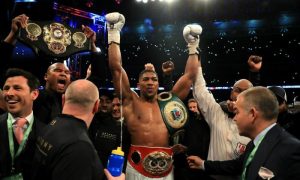By Bart Barry-

Saturday in an enormous Welsh rugby stadium heavyweight world champion Anthony Joshua beat Franco-Cameroonian Carlos Takam by a round-10 referee stoppage whose referee itched to stoppage it from just about the opening bell. Faced with such odds on short notice Takam made a fine showing for himself, and Joshua didn’t do badly either.
All three men did their jobs Saturday in Great Britain. Joshua sold a whole lot of tickets and punched a gatekeeper often enough to please ticketbuyers. Takam kept the gate, fighting like a proud man who knew victory was likely as a miracle and th’t short of a miracle a dignified showing’d further his career further than alternative approaches (Deontay Wilder’s nowhere near crazy as he swings and knows better than to cross the pond and get chloroformed by a fighter who knows how; Takam’s got a handsome 2018 payday awaiting him in Alabama). And referee Phil Edwards delivered the stoppage everyone wanted to preserve Joshua’s 100-percent knockout ratio – even going so far as to leave a white towel hanging off the cornerpost midway through the match, lest the Takam corner miss its cue.
With Wladimir Klitschko retired it’s exhibition matches far as the eye can see for Joshua, and so a new sort of judging criterion is required for American fans who can’t warm to Joshua much more than we warmed to Klitschko. Helpfully Europeans fill stadiums with an inexplicable enthusiasm that is nearly infectious. One needn’t be a publicist or promoter to have a rooting interest in the health of our beloved sport’s ecosystem; the optics of 78,000 folks in a stadium in Wales to see a prizefight, or even half that, something no American prizefighter can give us, makes a spectacle enough to prompt popish coverage enough to spark a few American kids’ enthusiasm enough to lure them off a popwarner field or littleleague diamond into a boxing gym, which American boxing needs quite desperately, kids who learn to box instead of men who wash out their preferred sports then give boxing a try after they’re a decade too old to move better than mechanically.
Writing of mechanical movement and Klitschko and Joshua, it’s Joshua’s movement that allures in a way Klitschko’s never did or even approached doing. Whatever his record Wladimir Klitschko generally fought like a skittish robot programmed to call on three offensive scripts that went jab.jab.jab.jab or jab.jab.jab.hook or jab.jab.hook.cross. Everything else Klitschko did in a fight, leaping backwards and setting his chin 60 inches behind his left fist and armswrapping and alternately chesting shorter opponents’ foreheads or pattycaking their lead hands, was done to preclude combat; once he had a much smaller man properly attritioned Klitschko would use these tactics tactically and maybe even offensively but they were not born of aggression.
Where Klitschko often moved in championship prizefights like a scared giant Joshua moves like a fighter – like he wants to measure accurately his gifts, tangible and otherwise, not collect meaningless defenses like a statistician then sue posterity with accumulated evidence. Joshua steps with the jab, pistonstroking it outwards from his chest. By keeping the leadhand home Joshua does these two things among others: He gives an opponent a running start at him Klitschko would never allow, and he generates more force. In other words Joshua sacrifices a quotient of his safety to endanger his opponent more fully; that’s the proposition of a fighter who has immense athleticism, as opposed to an immense athlete who happens to fight.
Early in Saturday’s contest Joshua did something else interesting: He measurejabbed over his shorter opponent’s head. Knowing Takam’s only realistic chance at progress was lowrushing charges Joshua encouraged Takam to get lower still, the better to impale Takam on an uppercut. This approach proved unwise risktaking by Joshua as Takam had seasoning enough with taller opponents to navigate his way round and inside and drive his head square into Joshua’s nose, which bracejolts you with pain no matter who you are.
It brought an unlikely association with Chris Byrd, of all past heavyweights, and an infighting drill he once mentioned and some of us tried – the tire drill. This meant setting a truck tire on the floor between two men and having them spar with one foot in it. Tire drill favored the shorter man, or at least the lower man, as head collisions were inevitable and you wanted the top of your head being the point of impact, rather than your chin or nose. A couple of us got to bleeding very quickly, and a trainer cancelled the tire drill hundreds of hours of practice before any of us could do a passable Chris Byrd.
Broken nose or otherwise Joshua spent the rounds after he got bracejolted by Takam’s head punching Takam very hard. Joshua throws his punches very well, and he commits to them, snapping his hips at the target. Critics of Joshua, including one Bronze Bomber, tweeted on his stamina. At no moment was Joshua in danger of losing a round much less the match, though, so how bad might his stamina be? Joshua likely carries too much muscle in the ring – and how he attained and maintains that muscle, you can bet, will be the primary reason Deontay Wilder chooses to say he’s choosing not to fight Joshua, loudly hiding from Joshua behind VADA approval the way Floyd Mayweather hid from Manny Pacquiao with USADA, and probably just as disingenuously – but in this current era of heavyweights no opponent is going to stay so busy Joshua can’t keep up.
After all, how many aficionados can even name 10 heavyweights these days? I’m going to try: Joshua, Wilder, Povetkin, Takam . . .
Bart Barry can be reached via Twitter @bartbarry









